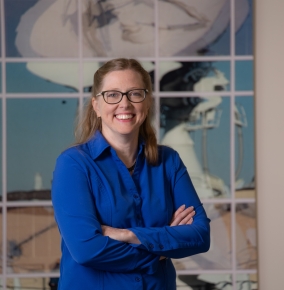Emily Peterson

How did you come to join the Laboratory?
My path started in the academia pure-science perspective of grad school, through a postdoc at Argonne National Lab. I considered applying for professorships in AMO [atomic, molecular, and optical] physics research next but decided to go into industry instead. I joined the lighting company Osram-Sylvania, which was doing R&D in plasma spectroscopy and chemical vapor transport — the inside of light bulbs is very complex! Some of the challenges of setting research directions based on consumer choices and profits made industry not a great fit for me. By the time I joined Lincoln Lab in 2014, I appreciated the way we sit at the juncture between government, academia, and industry. We do real-world, goal-oriented projects but with academic curiosity and depth of understanding.
What is a typical workday like?
As a lidar sensor designer, I’m integrating technology pieces from all over the Lab. That means talking with the laser and detector technology groups about a custom laser or camera that my project will be the first user of, talking with optical or electrical engineers about designs, or talking with mechanical or thermal engineers about sensor performance in a field environment. Some days I’m focusing on what the sponsor needs the sensor to accomplish and modeling how well a design might perform. Some days I’m brainstorming with engineers about long-term technology development paths that could help a future sensor perform better. Some days I’m talking with programmers and analysts about how to connect raw data to the questions we’re trying to answer. Some days I’m working with field sites to set up test campaigns or making measurements in the lab. But all my days involve talking and listening, and pulling together people, information, and expertise. I have to keep my technical understanding both broad enough and deep enough to ensure the essential points from everyone I talk to are communicated effectively to the whole team.
Do you have any career wisdom to share?
I remember knowing that I liked doing physics but finding it difficult to translate that into a professional path. The key is to be able to recognize your dream job when it comes along, as it might not be what you expect. In every project, from undergrad through grad school and into first jobs, you’re learning not only technical skills but also who you are professionally and what you want your career to look like: Do you learn better from talking or reading? Do you like working on multiple projects or one at a time? Do you like seeing shaky first results from a brand-new experiment or refining something until it’s working really well? Would you rather do a task you don’t enjoy for a project you really care about or vice-versa? When all of these aspects of a job match up — or better yet, when you’re able to define a role so that it matches up with the way you want to work — you’re going to excel and build a career in the direction you want.
What most excites you about the future of lidar sensing?
Twenty or thirty years ago, building a lidar sensor was a crazy science experiment, and every system the Lab built was novel and/or risky compared to the previous generation. These days, commercial lidars are thriving at all scales, from airborne surveys through self-driving car technology, and even iPhones have a short-range lidar. I’m excited to see where we can go next and what it means to be at the cutting edge of a technology proliferating so fast.
Which activity do you enjoy doing in your free time?
I love playing traditional Irish music on concertina, and the Boston area has so many opportunities for that. An Irish session is a place where you can hear great music played, play old tunes with friends, learn new music, and meet new people. It amazes me that I can sit down with someone I’ve never met before, name a common piece, and, in two minutes, we’re playing together; the tradition is so consistent no matter where you go.